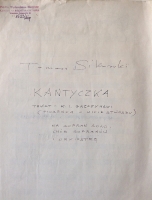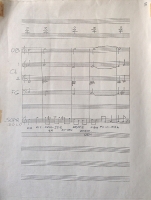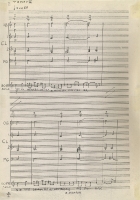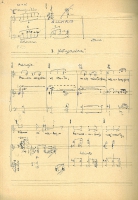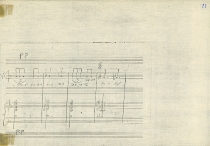Composing was a natural activity for Tomasz Sikorski. He watched his father, Kazimierz, at work and, like most children, tried to copy him. His mother, Helena, was Kazimierz Sikorski’s pupil, so the children must have inherited their musical talent from both parents. At the Sikorskis’ music – be it in the form of sheet music, records or live performances – was a constant presence. Tomasz Sikorski played the piano from a very early age and he must have improvised as well. Small pieces for piano, written while he was still in Łódź in the 1940s, were his first attempts at composition. However, he was ashamed of them and buried them to prevent them from getting into the wrong hands. According to Zygmunt Krauze, when Sikorski was still in high school in Łódź, he began writing Echoes, a piece directly inspired by the acoustic phenomenon. Later, when he transferred to a state music school in Warsaw, he and Zbigniew Rudziński took part in extra-curricular harmony classes conducted by Aleksander Jarzębski, a distinguished teacher and headmaster of the school at the time, who died tragically in a plane crash in 1962. As Zbigniew Rudziński recalls, the teacher organised a concert presenting the compositions they had written during those extra-curricular classes. It was in that period that Sikorski wrote the first pieces we know by title. The were written mostly for piano: Diptych – Pastorale e Toccattina, Triptych, Little Triptych, Five Miniatures, Five Preludes. All of them are dated 1955. Two of the Five Preludes were published one year later by PWM Edition, which must have been a great honour for the young composer barely on the brink of adulthood. The only other piece that has survived from that group is Diptych.
In 1956 Sikorski wrote three compositions which happily have survived to this day:
- Capriccio for piano and small orchestra, which the composer renamed Little Concerto before 1965,
- Song (Cantata, Canticle) of Wit Stwosz for soprano, choir of sopranos and chamber orchestra to words by Konstanty Ildefons Gałczyński (published by Agencja Autorska in 1990) and
- Five Songs to words by Konstanty Ildefons Gałczyński for voice and piano, which the composer offered to PWM Edition in 1986 after introducing some cosmetic changes.
The remaining works written by Sikorski during his studies at the State School of Music in Warsaw which have not survived are: Sonata for piano, Symphony for string orchestra, Reed Trio (1958), Variants for piano and four percussion groups (1960), Echoes I for piano and percussion (1961), Echoes II for five performers (1962), Sketches for string quartet (1962) and Strettas for chamber choir and instruments (1962). These are titles given by the composer himself, but we cannot rule out the possibility that Sikorski made some additional, less substantial attempts at composition in that period.
His surviving youthful pieces are characterised by a still traditional approach to the musical material. The composer uses bar notation on staves in these works, he does not use any non-standard ways of producing sound, but he does display considerable harmonic inventiveness. Sikorski presents himself as a skilful composer able to put his own ideas into practice. His scores are clear and the works are well-balanced. There is no mannerism, exaggeration or pushiness in them.






